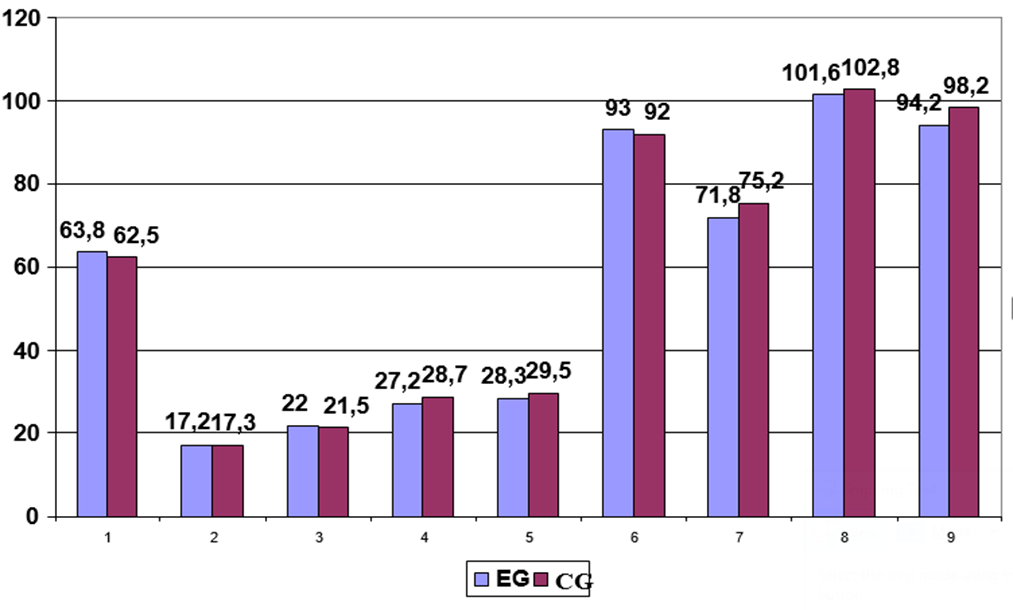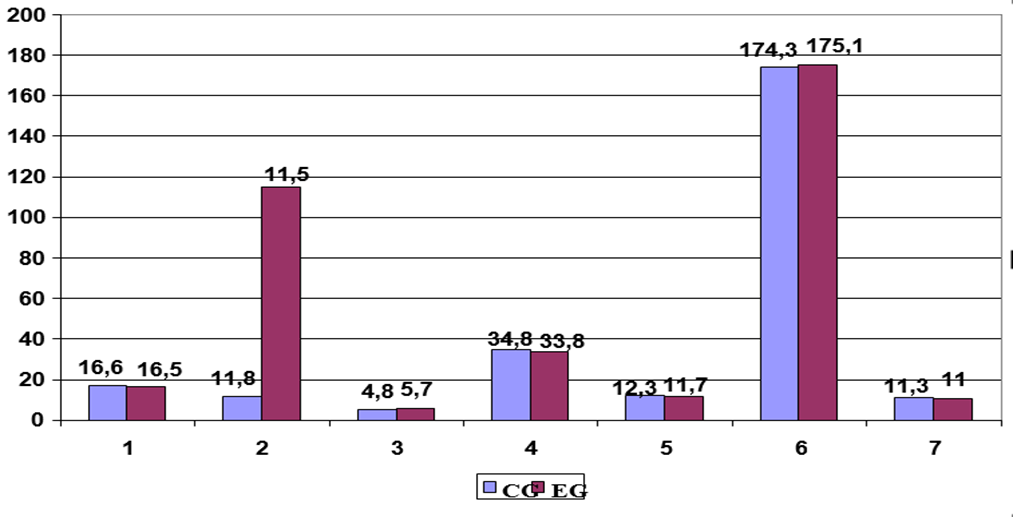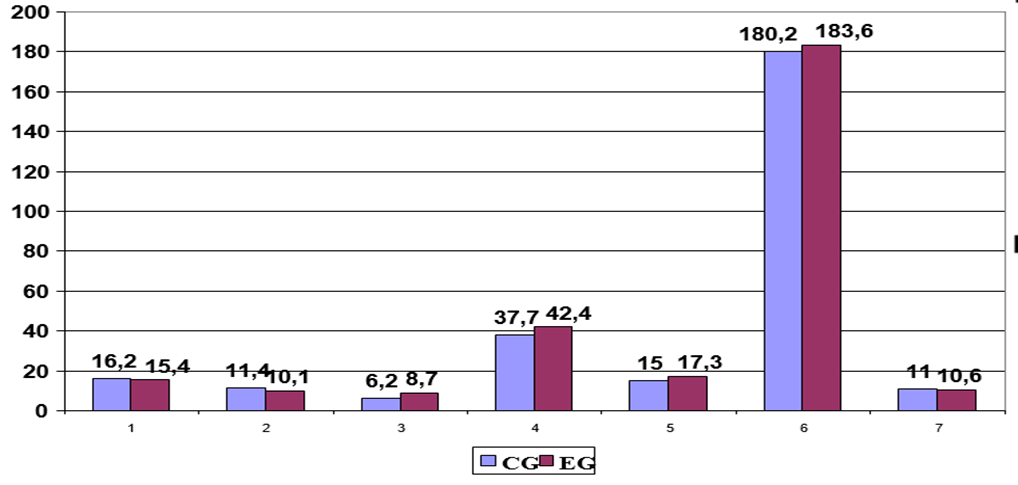Research Article | DOI: https://doi.org/10.58489/2836-2179/019
Modern Directions of Rhythmic Gymnastics as A Means of Increasing the Level of Physical Development and Physical Preparedness of Students
1Department Physical Culture and Sport Vasil StefanikPrecarpathian National University
*Corresponding Author: Serhii Popel*
Citation: Popel S.L, (2023) Modern Directions of Rhythmic Gymnastics as A Means of Increasing the Level of Physical Development and Physical Preparedness of Students 2(2). DOI: 10.58489/2836-2179/019
Copyright: © 2023 Serhii Popel, this is an open-access article distributed under the Creative Commons Attribution License, which permits unrestricted use, distribution, and reproduction in any medium, provided the original work is properly cited.
Received: 22 April 2023 | Accepted: 30 June 2023 | Published: 24 July 2023
Keywords: gymnastics, physical development, physical readiness.
Abstract
Today in Ukraine, the incidence among women remains high, and in some nosological units, especially in the musculoskeletal system, endocrine and reproductive systems, very high. At the same time, there is a powerful arsenal of rehabilitation and recreational tools and programs aimed at restoring and maintaining a safe level of physical health and the necessary quality of life for women in modern society. units, especially from the musculoskeletal system, endocrine and reproductive systems, very high. At the same time, there is a powerful arsenal of rehabilitation and recreational tools and programs aimed at restoring and maintaining a safe level of physical health and the necessary level of quality of life for women in modern society. to analyze the impact of various sports and health areas of rhythmic gymnastics under the program "Rhythmic gymnastics and aerobics in physical education classes" on the level of physical development and physical fitness of students. Analysis and systematization of scientific and methodological literature, observation, survey, testing of physical fitness; measurement of anthropometric indicators; methods of mathematical statistics. Modern directions of rhythmic gymnastics as a means of increasing the level of physical development and physical fitness of female students. The article presents the results of the study of the effectiveness of the author's program of complex use of modern sports and health-improving directions of rhythmic gymnastics and presents the results of studies of the influence of the program on the level of physical development and physical fitness of female students. Studies have shown that EG students have decreased anthropometric parameters when calibrating the subscapular and abdominal skin folds, decreased body weight, and shoulder circumference at rest. There is a significant increase (33.9%) in the parameters of flexibility when tilting the torso forward which is explained by the fact that in the complexes of exercises of the program was used a significant number of exercises that are associated with mobility not only in large but also, especially in small joints. The application of techniques for the development of dynamic force in various areas of strength aerobics has also increased the force in bending and unbending the arms in the supine position, as well as lifting in the saddle for 1 minute. Indicators of a long jump from a place and shuttle running in both groups do not differ essentially because, in the program of employment, there were no exercises of speed and power orientation. However, the measurement of aerobic cyclic movements (running 100 m) showed that in EG the indicator increased by 7.48%, and in CG - only by 2.49%. Indicators of aerobic capacity (running 2000 m) increased by 12.59%, while in EG, and in CG, this figure has not changed significantly - only 3.7%. Research has confirmed the effectiveness of the proposed rhythmic gymnastics and aerobics program, aimed at improving the level of physical development and physical fitness of students. The program developed by us gives the chance to carry out combined employment in various directions of rhythmic gymnastics in sports clubs and sports sections or groups of the improving and rehabilitation direction and other sports and improving establishments.
Problem statement and analysis of the results of recent research
It is well known that the modern rhythm of life, and environmental conditions are negative factors that affect the morpho-functional state of man. Particularly sensitive to the effects of these factors is the female body, which carries an additional family and social burden [1].
Today in Ukraine, the incidence among women remains high, and in some nosological units, especially in the musculoskeletal system, endocrine and reproductive systems, very high. At the same time, there is a powerful arsenal of rehabilitation and recreational tools and programs aimed at restoring and maintaining a safe level of physical health (PH) and the necessary level of quality of life for women in modern society [1].
Unfortunately, today recovery is understood only in the aspect of the restoration of already lost functions of separate bodies and systems of an organism, accordingly, programs on physical training are developed also. Another aspect of rehabilitation is left out of consideration - the developmental one, which belongs to a much larger, almost healthy part of the female population. [5,6].
Today, the problem of women's health has acquired a state character and has become the subject of research in various fields of science: medicine, biology, and pedagogy. Research on this issue in the field of physical education is actively conducted, which shows the state of health and physical fitness of women [7].
Analysis of scientific research [1, 2, 5] shows that the fastest and most effective way to improve the psycho-physical condition and PH of the female population is regular exercise and tempering, which increases the vitality of young women, its natural immunity, improves the autonomic nervous system, physical performance and create anti-aging effect [10].
One of the types of rehabilitation, which has become very popular among women, especially young people (18-25 years old), is aerobics. Such groups are formed by age, professional, family, and other principles, which allows creating of the necessary psycho-social climate, which along with aerobic factors has an optimizing effect on the morpho-functional state of the body and its supporting systems and cardio-respiratory system, in particular.
Thus, the large number of proposals and recommendations in this area is due to the fact that research in this area is relatively new and requires modern scientific justification and generalization. Each of the existing modern areas of health gymnastics is considered and used as a separate technique. At the same time in the modern scientific literature due attention to its impact and integrated application of various sports and health gymnastics on the physical development and health of young women remains undeveloped, which is of theoretical and practical interest to specialists in physical culture, sports, and medicine. This provision determined the relevance and necessity of one's own research.
The work was performed according to the research plan of Vasyl Stefanyk Precarpathian National University (PNU): "Sexual dimorphism in the mechanisms of adaptation to physical activity in adolescence during sports and health classes", state registration number 0113U002431».
The aim of the study
This is to analyze the impact of different sports and health areas of rhythmic gymnastics under the program "Rhythmic gymnastics and aerobics in physical education classes" on the level of physical development and physical fitness of students aged 18-25 years.
Our research was subordinated to the following tasks: 1. To develop and experimentally test the effectiveness of the program "Rhythmic gymnastics and aerobics in physical education classes" of integrated use of health and fitness areas of gymnastics for students 18-25 years. 2. Investigate the impact of sports and fitness exercises on the physical development and physical fitness of students aged 18-25.
Material and methods
The study involved 30 students of PNU aged 18-25 years, which were divided into experimental (EG; n = 15) and control (CG; n = 15) groups. Research in EG was conducted in aerobics groups on the basis of a sports club under our program "Rhythmic Gymnastics and Aerobics in physical education classes." CG students were engaged on the basis of the Department of Physical Education PNU. Vasyl Stefanyk according to the generally accepted program of physical culture.
The results of the study
One of the tasks of the work was to develop a program of classes with integrated use of various modern areas of rhythmic gymnastics: stretching,
step aerobics, dance aerobics, yoga, football, swimming and other sports. , training at special seminars, fitness conferences and personal practical experience of a fitness instructor, as well as taking into account the basic principles and methods of theory and methods of physical education, created and implemented a program of aerobics classes, designed for 9 months throughout the school year.
This training macrocycle consisted of three mesocycles, each lasting 3 months and consisting of separate weekly microcycles. The first period - is the initial - September - November, the second period (training) - December - February, and the third period (improvement of morpho-functional state) - March-May.
The program is designed in such a way that some complex classes in rhythmic gymnastics used various tools that affect all functional organs and systems of the body. Classes in the author's program in aerobics were held three times a week. Each individual lesson lasted 45-60 minutes and had a traditional structure, which included preparatory, main, and final parts. The program included a variety of traditional and non-traditional exercises using standard and non-standard modern equipment. For the preparatory and final part of the lesson, exercises were selected depending on the tasks set for each lesson. Most often, these were exercises to develop flexibility, form the correct posture and proper breathing [11], restoration of the body's systems, which were performed to the musical accompaniment of moderate or low intensity. The main part of the lesson consisted of the selection of movements of modern types of aerobics and rhythmic gymnastics. In the main part of the lesson, the intensity of movement increased by increasing the pace of musical accompaniment During the experiment, physical activity was gradually increased by increasing the time and intensity of the main part of the lesson, changing the directions and sets of exercises, increasing the number of motor actions and the number of repetitions of individual exercises, changes in weight during exercises with different equipment.
Specific tasks were set for each period of classes: at the first stage - to form interest in participating in the experiment and systematic classes in various modern areas of physical culture, to coordinate motor skills with musical accompaniment, to promote gradual adaptation of the body to exercise; at the second stage - to promote the development of physical qualities, the formation of skills of performing physical exercises with objects, improving the technique of performing the proposed exercises; on the third to promote the development of physical qualities and improve overall physical performance. To determine the level of physical development used anthropometric methods: [2; 3; 4].
The results of the study are presented in Figures 1, 2.
Notes: 1 - body weight, 2 - subscapular skin fold, 3 - abdominal fold; 4 - the circumference of the relaxed arm, 5 - the circumference of the bent tense arm; 6 - circumference of the chest, 7 - circumference of the waist, 8 - circumference of the buttocks; 9 - hip circumference. Studies have shown that anthropometric indicators in the calibration of subscapular and abdominal skin folds decreased by 23.9% in EG students. Body weight in CG has not changed. It was 63.8 ± 4.2 kg at the beginning of the experiment and 63.6 ± 4.2 kg after the experiment. In EG students, body weight at the beginning of the experiment was 62.5 ± 4.3 kg, and at the end of 58.9 ± 3.3 kg, i.e. decreased by 6.2% (p<0>
The difference in the measurement of the girth of the shoulder, thigh, and waist in the CG has not changed, and in the EG - the circumference of the shoulder at rest decreased by 5.69%; bent tense arm - by 2.11%; tightened - by 3.19%; waist by 4.79%. To study the level of physical fitness, state tests and standards for assessing the state of physical fitness of the population of Ukraine were used [3]. The research results are presented in Figures 3, 4.
Notes: 1 - 100 m run; 2 - running 2000 m; 3 - tilt the torso forward from a sitting position, cm; 4 - lifting the torso to the side in one minute, times; 5 - flexion and extension of the arms lying down, times; 6 - long jump from a place, cm; 7 - shuttle run 4x9m, sec.
The results of measurements showed that in EG in female students who systematically engaged in various areas of rhythmic gymnastics and aerobics, significantly changed the parameters of flexibility when tilting the torso forward - this increase was 33.9% and is due to the fact that in the exercise complex the number of exercises that are associated with mobility not only in large but also, especially in small joints. The use of techniques for the development of dynamic strength in various areas of strength aerobics also allowed for increasing the force in bending and unbending the arms in the supine position by 31.97%, as well as lifting in the saddle for 1 minute. at 19.81%. Indicators of long jump from the place and shuttle running in both groups do not differ significantly, because in the training program, there were no exercises of speed-strength orientation. However, the measurement of aerobic cyclic movements (running 100 m) showed that in EG the indicator increased by 7.48%, and in CG - only by 2.49%. Indicators of aerobic capacity (running 2000 m) increased by 12.59%, while in EG, and in CG, this figure has not changed significantly - only 3.7%.
Conclusion
Research has confirmed the effectiveness of the proposed rhythmic gymnastics and aerobics program, aimed at improving the level of physical development and physical fitness of female students. The program developed by us gives the opportunity to conduct combined classes in different areas of rhythmic gymnastics in sports clubs and sports sections or groups of health and rehabilitation and other sports and health facilities.
Further research is expected
To be conducted in the direction of studying the impact of rhythmic gymnastics classes as a means of improving the level of physical development and physical fitness of female students.
References
- Apanasenko GL, (2018). Popova LA Medical valeology.K .: Health,.
View at Publisher | View at Google Scholar - Brizhatyy O.V., Pidlisnyy V.I. (2017). snovy naukovykh doslidzhenʹ u fizychniy kulʹturi ta sporti: Naukova pratsya.[Fundamentals of scientific research in physical culture and sports: Scientific work.] – Sumy: SOD.
View at Publisher | View at Google Scholar - Zubaliy M.D.( 2017). Derzhavni testy i normatyvy otsinky fizychnoyi pidhotovlenosti naselennya Ukrayiny [State tests and standards for assessing the physical fitness of the population of Ukraine]. – К.
View at Publisher | View at Google Scholar - Ivanov I.I.( 2018). Anthropometry in medicine. M .: Medicine.
View at Publisher | View at Google Scholar - Lisitskaya TS (2019). Rhythmic plastic surgery: 230 exercises. M .: FiS.
View at Publisher | View at Google Scholar - Menhin Yu.V., Menhin A.V.(2022). Health gymnastics: theory and methods. - Rostov-on-Don: Phoenix.
View at Publisher | View at Google Scholar - Potashnyuk R.Z.(2019). Sotsialʹno-ekolohichna sutnistʹ zdorovʺya.[ Socio-ecological essence of health] Lutsʹk.
View at Publisher | View at Google Scholar - Romanenko VA (2019). Human motor abilities. Donetsk: UK Center.
View at Publisher | View at Google Scholar - Kholodov Zh.K., Kuznetsov VS (2022). Theory and methods of physical education and sports. - M .: Izd. Academy Center.
View at Publisher | View at Google Scholar - Kolesnik M.Yu.(2017).Physical culture is the main anti-aging tool of the modern disease prevention system. Mat-li IV Congress
View at Publisher | View at Google Scholar - Faychak R.I., Popel S.L.(2019).Breathing gymnastics. Methodical manual for students of physical education faculties. Ivano-Frankivsk: НУ,; 1: 151.
View at Publisher | View at Google Scholar



